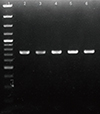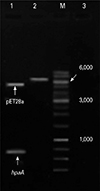1. Unidentified curved bacilli on gastric epithelium in active chronic gastritis. Lancet. 1983; 1:1273–1275.
2. Massarrat S, Saberi-Firoozi M, Soleimani A, Himmelmann GW, Hitzges M, Keshavarz H. Peptic ulcer disease, irritable bowel syndrome and constipation in two populations in Iran. Eur J Gastroenterol Hepatol. 1995; 7:427–433.
3. Dunn BE, Cohen H, Blaser MJ. Helicobacter pylori. Clin Microbiol Rev. 1997; 10:720–741.

4. Geis G, Suerbaum S, Forsthoff B, Leying H, Opferkuch W. Ultrastructure and biochemical studies of the flagellar sheath of Helicobacter pylori. J Med Microbiol. 1993; 38:371–377.

5. Osato MS, Reddy R, Reddy SG, Penland RL, Malaty HM, Graham DY. Pattern of primary resistance of Helicobacter pylori to metronidazole or clarithromycin in the United States. Arch Intern Med. 2001; 161:1217–1220.

6. Moss SF. Helicobacter pylori and apoptosis: is there consensus. Ital J Gastroenterol Hepatol. 1998; 30:160–161.
7. Permin H, Andersen LP. Inflammation, immunity, and vaccines for Helicobacter infection. Helicobacter. 2005; 10:Suppl 1. 21–25.

8. Robinson K, Argent RH, Atherton JC. The inflammatory and immune response to Helicobacter pylori infection. Best Pract Res Clin Gastroenterol. 2007; 21:237–259.

9. Carlsohn E, Nystrom J, Bolin I, Nilsson CL, Svennerholm AM. HpaA is essential for Helicobacter pylori colonization in mice. Infect Immun. 2006; 74:920–926.

10. O'Toole PW, Janzon L, Doig P, Huang J, Kostrzynska M, Trust TJ. The putative neuraminyllactose-binding hemagglutinin HpaA of Helicobacter pylori CCUG 17874 is a lipoprotein. J Bacteriol. 1995; 177:6049–6057.
11. Lundstrom AM, Blom K, Sundaeus V, Bolin I. HpaA shows variable surface localization but the gene expression is similar in different Helicobacter pylori strains. Microb Pathog. 2001; 31:243–253.

12. Nystrom J, Svennerholm AM. Oral immunization with HpaA affords therapeutic protective immunity against H. pylori that is reflected by specific mucosal immune responses. Vaccine. 2007; 25:2591–2598.

13. Soleimani N, Mohabati Mobarez A, Teymournejad O, Borhani K. Cytotoxicity effect of recombinant outer membrane inflammatory protein (oipA) of Helicobacter pylori on a breast cancer cell line. Modares J Med Sci Pathobiol. 2014; 17:57–66.
14. Soleimani N, Mohabati-Mobarez A, Atyabi F, Hasan-Saraf Z, Al Haghighi M. Preparation of chitosan nanoparticles carrying recombinant Helicobacter pylori neutrophil-activating protein. J Mazandaran Univ Med Sci. 2014; 23:134–144.
15. Soleimani N, Mobarez AM. Effect of recombinant neutrophil-activating protein (HP-NAP) of Helicobacter pylori on peritoneal macrophages. Iran J Public Health. 2014; 43:234.
16. Soleimani N, Mobarez AM, Olia MS, Atyabi F. Synthesis, characterization and effect of the antibacterial activity of chitosan nanoparticles on vancomycin-resistant Enterococcus and other gram negative or gram positive bacteria. Int J Pure Appl Sci Techonol. 2015; 26:14–23.
17. Daneshmandi S, Hajimoradi M, Soleimani N, Sattari M. Modulatory effect of Acetobacter xylinum cellulose on peritoneal macrophages. Immunopharmacol Immunotoxicol. 2011; 33:164–168.

18. Malfertheiner P, Megraud F, O'Morain CA, et al. Management of Helicobacter pylori infection: the Maastricht IV/Florence Consensus Report. Gut. 2012; 61:646–664.

19. Ueda J, Gosho M, Inui Y, et al. Prevalence of Helicobacter pylori infection by birth year and geographic area in Japan. Helicobacter. 2014; 19:105–110.

20. Saad AM, Choudhary A, Bechtold ML. Effect of Helicobacter pylori treatment on gastroesophageal reflux disease (GERD): meta-analysis of randomized controlled trials. Scand J Gastroenterol. 2012; 47:129–135.

21. Watanabe T, Tada M, Nagai H, Sasaki S, Nakao M. Helicobacter pylori infection induces gastric cancer in mongolian gerbils. Gastroenterology. 1998; 115:642–648.

22. Honda S, Fujioka T, Tokieda M, Satoh R, Nishizono A, Nasu M. Development of Helicobacter pylori-induced gastric carcinoma in Mongolian gerbils. Cancer Res. 1998; 58:4255–4259.
23. Salih BA, Abasiyanik MF, Ahmed N. A preliminary study on the genetic profile of cag pathogenicity-island and other virulent gene loci of Helicobacter pylori strains from Turkey. Infect Genet Evol. 2007; 7:509–512.

24. Ben Mansour K, Fendri C, Zribi M, et al. Prevalence of Helicobacter pylori vacA, cagA, iceA and oipA genotypes in Tunisian patients. Ann Clin Microbiol Antimicrob. 2010; 9:10.







